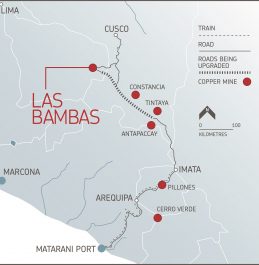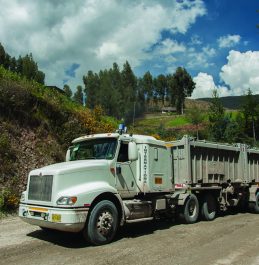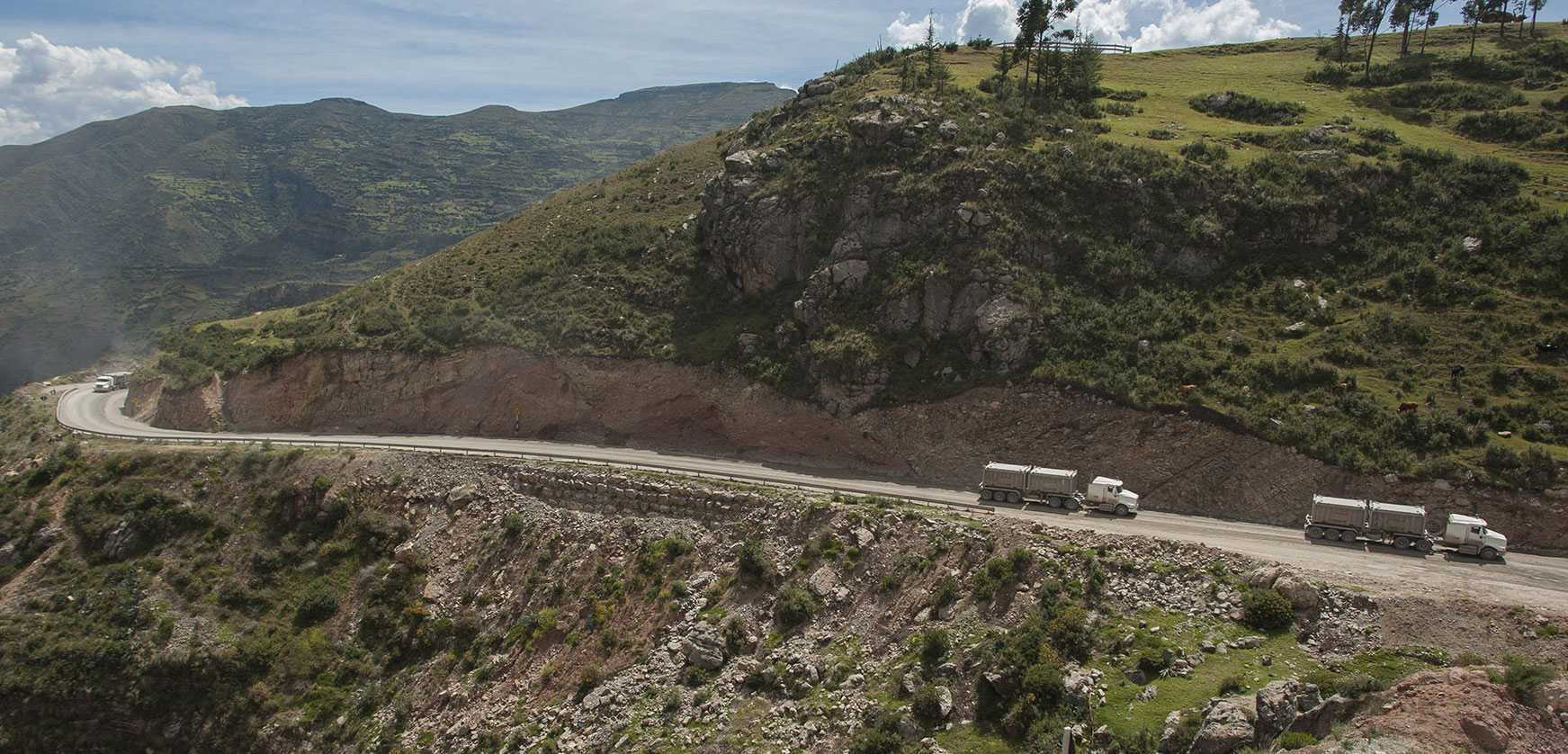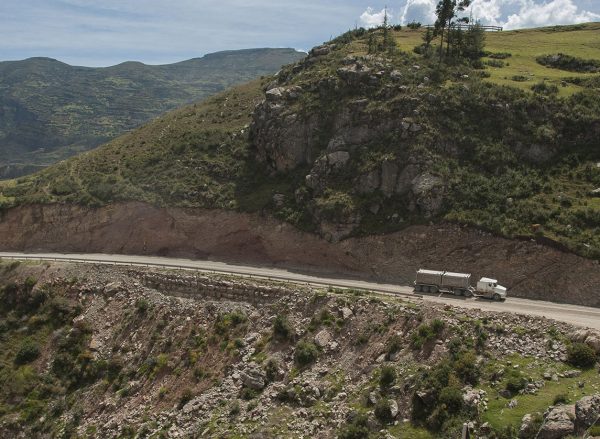The Las Bambas operation in Apurimac, Peru is a large, long life copper mine.
In recent times, the communities located on the road to Las Bambas have gone through significant changes with the upgrade of local infrastructure, including roads. Traffic has increased on these remote roads as production has ramped up to commercial rates during 2016 in a difficult and challenging mountainous region.
The road and rail corridor that starts at Las Bambas, passes important operations such as Antapaccay, Constancia and Cerro Verde on the way to the world’s largest concentrate port at Matarani. The road traverses three regions, five provinces, 14 districts and 60 communities.
This Q&A has been developed to provide an open, transparent account of the transportation of copper concentrate from the mine to the Port of Matarani.
Q. How is copper concentrate transported to the Port of Matarani?
- Copper concentrate is transported 458km by truck to Pillones Station, where it is transported a further 286km by train to the Port of Matarani.
- The trucks each transport two 17.3 tonne containers, transferring upwards of 3,600 wet metric tonnes, and equivalent to 106 trucks per day.
Q. What processes are being taken to limit the impact of the trucks?
- All containers involved in the transport of copper concentrate are sealed to prevent any accidental spillage.
- Prior to trucks passing, the road is watered to reduce the disturbance of the road and resultant dust.
- Las Bambas is currently sealing more than 80 km of road with micro paving within and around the communities where trucks pass. This work continues.
Q. How is MMG ensuring safety for the drivers and community?
- There is a team of more than 700 truck drivers and 100 escort drivers involved in the trucking of concentrate to Pillones Station.
- MMG is committed to the safety of every single one of these drivers and the community. Following the tragic death on Thursday 21 July of Felipe Leon Chavez, a driver who was employed through our logistics contractor Transaltisa, Las Bambas has been actively implementing initiatives to reduce fatigue and increase road safety.
- Some of these include; MMG has a strict no drugs or alcohol policy and regular testing is undertaken, internal and external cameras in each truck to alert fatigued drivers, bracelets for rest control for each driver as well as preventive and corrective maintenance programs.
Q. How will the investment in road infrastructure benefit the community?
- The investment in the road will continue to improve access and economic opportunities for local communities. Increase in traffic and transportation of goods will provide communities with new markets and possibilities. A reduction in transit time will provide communities with greater access to a host of services, a trip from Challhuahuacho to Arequipa will now take 7 hours less on the improved road.
Q. What issues have occurred between the use of the road and the community?
- Dust and noise from the trucks has been an issue for communities. Increased wetting of the road to reduce dust and investing in road improvements has been undertaken to mitigate community concerns.
- Our activities are underpinned by a grievance mechanism that is consistent with the remedy mechanisms under the UN Business and Human Rights Framework
- Las Bambas has invested more than USD$ 246 million into road improvement and maintenance.
Q. How have communities been engaged through this process?
- Las Bambas has worked for many years with the surrounding communities on access and road use agreements and road upgrades.
- The team at Las Bambas is committed to working with local communities to find long term, sustainable solutions to concerns, including noise and dust as a result of concentrate transport. The team is also working closely with the Peruvian Government as well as regional and community leaders along our transport corridor.
- We have a team at each one of the communities where the material is transported through.
- All the changes and improvements made to the project have been communicated and in compliance with required regulatory standards.
Q. What is the process of shipping concentrate from Pillones Station to the Port of Matarani?
- The train has a capacity for 54 containers, and is 348 meters long. Up to four trains can run per day, and it takes approximately 36 hours for the train to travel from Pillones Station to the Port of Matarani.
Q. What is the percentage of drivers who come from the local area?
- Currently 10% of drivers are from the local area, with a plan in place to grow this to 50% by 2018.
The Las Bambas operation in Apurimac, Peru is a large, long life copper mine. In recent times, the communities located on the road to Las Bambas have gone through significant changes with the upgrade of local infrastructure, including roads.
Traffic has increased on these remote roads as production has increased – in a difficult and challenging mountainous region.
The road and rail corridor that starts at Las Bambas, passes large mining operations including Antapaccay, Constancia and Cerro Verde on the way to the world’s largest copper concentrate port at Matarani. The road traverses three regions, six provinces, 16 districts and 86 communities.
The transportation of Las Bambas copper concentrate
Copper concentrate is transported 495km by truck to a train transfer station in Yanahuara district, where it is transported a further 286km by train to the Port of Matarani. The train has capacity for 54 containers, and is 348 metres long. Up to four trains can run per day, and it takes approximately 36 hours for the train to travel from Pillones Station to the Port of Matarani.
All containers involved in the transport of copper concentrate are sealed to prevent spillage. Prior to trucks passing, the road is watered to minimise dust. Las Bambas is currently sealing more than 80 km of road with micro-paving, within and around the communities where trucks pass.
More than 700 truck drivers and 100 escort drivers are involved and driver and community safety is the first priority. There is a strict no drugs or alcohol policy and regular testing is undertaken. Internal and external cameras in each truck alert fatigued drivers. Bracelets are provided to monitor rest for each driver, and preventive and corrective maintenance programs are regularly carried out. Currently 10% of drivers are from the local area, with a plan in place to grow this to 50% by 2018.
Tragically, even with good controls, Felipe Leon Chavez, a driver who was employed through our logistics contractor Transaltisa died in a road accident on Thursday 21 July 2016. Las Bambas is actively implementing initiatives to further reduce fatigue and increase road safety.
Community opportunities and impacts
Las Bambas has invested more than US$200m to upgrade the roads accessing Las Bambas, improving road access and economic opportunities for the entire region. The increase in traffic and transportation is providing communities with new markets and possibilities. For example, a trip from Challhuahuacho to Arequipa will now take 7 hours less on the improved road.
Las Bambas has worked for many years with the surrounding communities on access and road use agreements as well as road upgrades. As expected, improved access brings increased traffic, noise and dust. Watering of the road to reduce dust and investing in further road improvements has occurred to mitigate impacts and seek to address community concerns.
The team at Las Bambas is committed to working with local communities and the Peruvian Transport Authorities to find long term, sustainable solutions. A community relations team is based at each community along the road to provide regular communications and support. A joint working group of the Peru Government, Las Bambas and other regional stakeholders is preparing a proposal to upgrade and pave the road to national highway standards.
Pictured: Our concentrate is transported by truck and rail to the Port of Matarani in Arequipa, where it is shipped to customers worldwide.
-
 Map of the copper transportation route.
Map of the copper transportation route. -
 One of the Las Bambas trucks transporting copper concentrate.
One of the Las Bambas trucks transporting copper concentrate.





